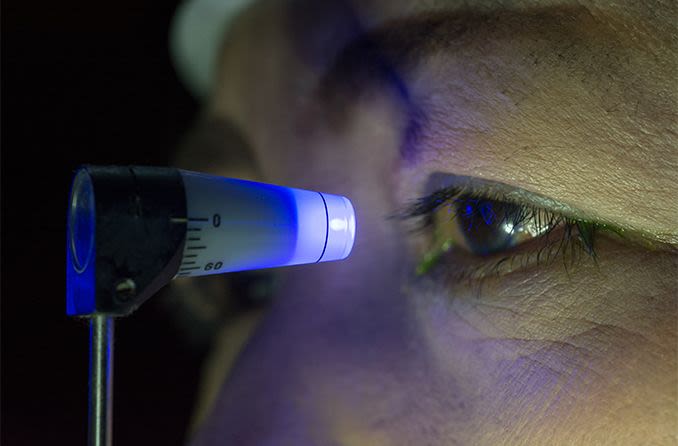Glaucoma eye pressure vs. normal eye pressure

Eye pressure that’s too high can lead to glaucoma, which slowly causes optic nerve fibers to die off. The optic nerve is the direct line of communication between the eye and the brain.
Naturally, you might think this would cause some kind of pain or discomfort, but that usually isn’t the case.
The most common form of glaucoma sets in “silently” over a long period of time, and usually with little to no warning. If glaucoma progresses and causes enough damage to the optic nerve, varying degrees of irreversible vision loss can occur, which also tends to be the first noticeable sign of the disease.
Fortunately, early diagnosis and treatment can significantly reduce or eliminate a patient’s chances of experiencing negative effects to their eyesight. Having your eyes examined routinely, even if you have 20/20 vision, can help your eye doctor catch this often treatable disease early.
With the help of an ophthalmologist or optometrist, monitoring and maintaining normal eye pressure are the most important ways a glaucoma patient can enjoy a lifetime of healthy eyesight.
NEED AN EYE EXAM? Find an eye doctor near you and make an appointment.
What is considered normal eye pressure?
The Glaucoma Research Foundation defines normal eye pressure as a measurement that falls between 12 and 22 mm Hg. The last part (mm Hg) stands for millimeters of mercury, the unit of measurement for inner-eye pressure.
If your eye pressure, also called intraocular pressure or IOP, registers higher than that range, it doesn’t automatically mean that you have glaucoma. If your eye doctor doesn’t see evidence of glaucoma, the condition is labeled ocular hypertension. This can exist on its own, or eventually lead to glaucoma.
Doctors refer to patients with ocular hypertension as glaucoma suspects.
Changes in eye pressure don’t usually cause any symptoms, so it’s especially important for glaucoma suspects to have their pressure levels measured regularly — the key to catching any changes before the optic nerve is damaged.
Some peoples’ optic nerves can withstand higher pressure without ever receiving damage, according to Dr. Charles Slonim, an ophthalmologist and professor at the University of South Florida.
“If there are no other signs of glaucoma, then high pressures can be followed and simply observed,” Slonim says. “Most docs will, however, treat a pressure greater than 30 mm Hg.”
Treating eye pressure means bringing it back down to within the normal range and keeping it there long-term to minimize the risk of optic nerve damage and vision loss.
How do you lower eye pressure?
Elevated eye pressure is usually reduced and controlled with glaucoma eye drops. There are many types of eye drops that can reduce glaucoma eye pressure.
The most popular of these options are called prostaglandins. These prescription eye drops reduce eye pressure by allowing the aqueous fluid that’s produced inside the eye to drain more easily from the eye. The balance of the rate of production and degree of outflow of this fluid is what determines intraocular pressure.
In some cases, your eye doctor may also recommend glaucoma surgery.
While there are still unknowns in the world of glaucoma research, medical professionals do know that patients can benefit from treating optic nerve health in addition to eye pressure levels.
“Current research is suggesting that optic nerve nutrition can be enhanced with certain drugs and also with certain nutritional agents, like ginkgo biloba,” says Dr. Burt Dubow, a senior partner at Insight Eye Care in St. Cloud, Minnesota.
“My suggestion would be to avoid smoking and excessive alcohol, eat a healthy diet, keep your weight down, exercise, take nutritional products and be sure to see your eye specialist on a regular basis,” Dubow says.
Before taking any herbal or nutritional supplements for glaucoma, be sure to discuss this with your eye doctor.
READ NEXT: Hypotony: Low Eye Pressure
Is glaucoma always caused by high eye pressure?
When people think of glaucoma, they’re usually thinking of primary open-angle glaucoma (also called chronic glaucoma or POAG). Rightfully so — it accounts for around nine out of every 10 glaucoma diagnoses. Open-angle glaucoma is caused by a slow buildup of intraocular pressure.
Angle-closure glaucoma (or narrow-angle glaucoma), on the other hand, while rare, develops quickly due to a sudden increase in IOP and requires urgent medical attention.
Additionally, there are congenital forms of the disorder present from birth, and types of secondary glaucoma that result from injury or an underlying disease. But they too are the results of elevated eye pressure.
A disorder called normal-tension glaucoma can result in optic nerve damage, even at seemingly normal eye pressure levels. However, some medical professionals simply classify it as a slower, less aggressive form of the more common open-angle glaucoma.
It can seem strange to schedule an eye exam when your eyes feel fine and you are seeing clearly. But regular comprehensive eye exams, even in the absence of any noticeable symptoms, can be critical to the early diagnosis and treatment of glaucoma.
IF IT’S BEEN A WHILE SINCE YOUR LAST EYE EXAM: Find an eye doctor near you and schedule an appointment.
Page published on Friday, June 12, 2020




